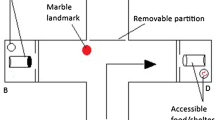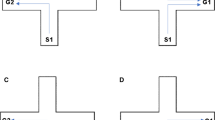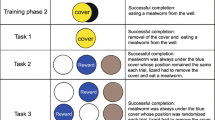Abstract
Increasing evidence suggests that cognitive function is under selection in diverse taxa and that this results in different cognitive abilities in taxa experiencing different selective environments. For example, species inhabiting spatially complex environments might be expected to have good spatial learning ability. We investigated whether local habitat conditions influence learning by comparing the performance of two recently diverged species of threespine stickleback (Gasterosteus aculeatus complex) in a spatial learning task. The two species reside sympatrically in several lakes. Benthics occupy the spatially structured vegetated littoral zone, whereas limnetics occupy the spatially homogenous open-water pelagic zone. We trained fish to locate a hidden reward in a T-maze and asked whether they did so by learning a body-centred pattern of movement (turn left or right) or by using plant landmarks. Both benthics and limnetics used turn and landmark cues, but benthics learnt the task almost twice as quickly as limnetics. This difference is consistent with the hypothesis that benthic and limnetic sticklebacks are equipped with spatial learning abilities well suited to the spatial complexity of their littoral and pelagic habitats. Our findings add to the understanding of the evolution of learning.






Similar content being viewed by others
References
Able KP (1993) Orientation cues used by migratory birds: a review of cue-conflict experiments. Trends Ecol Evol 8:367–371
Ancel LW (1999) A quantitative model of the Simpson–Baldwin effect. J Theor Biol 196:197–209
Anderson RW (1995) Learning and evolution: a quantitative genetics approach. J Theor Biol 175:89–101
Balda RP, Pepperberg IM, Kamil AC (1998) Animal cognition in nature: the convergence of psychology and biology in laboratory and field. Academic, London
Bentzen P, McPhail JD (1984) Ecology and evolution of sympatric sticklebacks (Gasterosteus)—specialization for alternative trophic niches in the Enos Lake species pair. Can J Zool 62:2280–2286
Bentzen P, Ridgway MS, McPhail JD (1984) Ecology and evolution of sympatric sticklebacks (Gasterosteus)—spatial segregation and seasonal habitat shifts in the Enos Lake species pair. Can J Zool 62:2436–2439
Bolhuis JJ, Macphail EM (2001) A critique of the neuroecology of learning and memory. Trends Cog Sci 5:426–433
Braithwaite VA, Girvan JR (2003) Use of water flow direction to provide spatial information in a small-scale orientation task. J Fish Biol 63:74–83
Brick O, Jakobsson S (2002) Individual variation in risk-taking: the effect of a predatory threat on fighting behavior in Nannacara anomala. Behav Ecol 13:439–442
Brodbeck DR (1994) Memory for spatial and local cues: a comparison of a storing and a nonstoring species. Anim Learn Behav 22:119–133
Brown C, Warburton K (1999) Differences in timidity and escape responses between predator-naive and predator-sympatric rainbowfish populations. Ethology 105:491–502
Clayton NS, Krebs JR (1994) Memory for spatial and object-specific cues in food-storing and non-storing birds. J Comp Phys A 174:371–379
Cole S, Hainsworth FR, Kamil AC, Mercier T, Wolf LL (1982) Spatial learning as an adaptation in hummingbirds. Science 217:655–657
Collett TS, Zeil J (1998) Places and landmarks: an arthropod perspective. In: Healy S (ed) Spatial representation in animals. Oxford University Press, Oxford, pp 18–53
Chivers DP, Mirza RS, Johnston JG (2002) Learned recognition of heterospecific alarm cues enhances survival during encounters with predators. Behaviour 139:929–938
Dukas R (1998) Cognitive ecology: the evolutionary ecology of information processing and decision making. The University of Chicago Press, Chicago
Dukas R (1999) Costs of memory: ideas and predictions. J Theor Biol 197:41–50
Etienne AS, Teroni E, Hurni C, Portenier V (1990) The effect of a single light cue on homing behaviour of the golden hamster. Anim Behav 39:17–41
Fraser DF, Gilliam JF, Daley MJ, Le AN, Skalski GT (2001) Explaining leptokurtic movement distributions: intrapopulation variation in boldness and exploration. Am Nat 158:124–135
Frommen JG, Luz C, Bakker TCM (2007) Kin discrimination in sticklebacks is mediated by social learning rather than innate recognition. Ethology 113:276–282
Girvan JR, Braithwaite VA (1998) Population differences in spatial learning in three-spined sticklebacks. Proc R Soc Lond, B 265:913–918
Godin JGJ (1995) Predation risk and alternative mating tactics in male Trinidadian guppies (Poecilia reticulata). Oecologia 103:224–229
Gow JL, Peichel CL, Taylor EB (2007) Selection against hybrids in natural populations of sympatric threespine sticklebacks. J Evol Biol 20:2173–2180
Hatfield T, Schluter D (1999) Ecological speciation in sticklebacks: environment-dependent hybrid fitness. Evolution 53:866–873
Healy S, Braithwaite VA (2000) Cognitive ecology: a field of substance? Trends Ecol Evol 15:22–26
Healy SD, Krebs JR (1993) Development of hippocampal specialisation in a food-storing bird. Behav Brain Res 53:127–131
Healy SD, Clayton NS, Krebs JR (1994) Development of hippocampal specialisation in two species of tit (Parus spp.). Behav Brain Res 61:23–28
Hughes RN, Blight CM (1999) Algorithmic behaviour and spatial memory are used by two intertidal fish species to solve the radial maze. Anim Behav 58:601–613
Hughes RN, Blight CM (2000) Two intertidal fish species use visual association learning to track the status of food patches in a radial maze. Anim Behav 59:613–621 109:46–57
Irwin DE, Price T (1999) Sexual imprinting, learning and speciation. Heredity 82:347–354
Jablonka E, Lamb MJ (2005) Evolution in four dimensions. Genetic, epigenetic, behavioral and symbolic variation in the history of life. MIT Press, Cambridge
Jacobs LF, Gaulin SJC, Sherry DF, Hoffman GE (1990) Evolution of spatial cognition: sex-specific patterns of spatial behavior predict hippocampal size. Proc Nat Acad Sci 87:6349–6352
Jenkins J (1997) Pavlovian conditioning of sexual behavior in male threespine stickleback (Gasterosteus aculeatus). Behav Proc 41:133–137
Jenkins JR, Rowland WJ (1996) Pavlovian conditioning of agonistic behavior in male threespine stickleback (Gasterosteus aculeatus). J Comp Psychol 110:396–401
Juraska JM, Henderson C, Muller J (1984) Differential rearing experience, gender, and radial maze performance. Dev Psychobiol 17:209–215
Kamil AC (1998) On the proper definition of cognitive ethology. In: Pepperberg IM, Kamil AC (eds) Animal cognition in nature: the convergence of psychology and biology in laboratory and field. Academic, London, pp 1–28
Kozak GM, Boughman JW (2008) Experience influences shoal member preference in a species pair of sticklebacks. Behav Ecol 19:667–676
Krebs JR, Healy SD, Shettleworth SJ (1990) Spatial memory of Paridae: comparison of a storing and a non-storing species, the coal tit, Parus ater, and the great tit, P. major. Anim Behav 39:1127–1137
Krebs JR, Clayton NS, Healy SD, Cristol DA, Patel SN, Jolliffe AR (1996) The ecology of the avian brain: food-storing memory and the hippocampus. Ibis 138:34–46
Lefebvre L (1996) Ecological correlates of social learning: problems and solutions for the comparative method. Behav Proc 35:163–171
Losey GS, Sevenster P (1995) Can three-spined sticklebacks learn when to display—rewarded displays. Anim Behav 49:137–150
Mackney PA, Hughes RN (1995) Foraging behaviour and memory window in sticklebacks. Behaviour 132:1241–1253
Markel RW (1994) An adaptive value of spatial learning and memory in the blackeye goby, Coryphoterus nicholsi. Anim Behav 47:1462–1464
McPhail JD (1984) Ecology and evolution of sympatric sticklebacks (Gasterosteus)—morphological and genetic evidence for a species pair in Enos Lake, British Columbia. Can J Zool 62:1402–1408
McPhail JD (1992) Ecology and evolution of sympatric sticklebacks (Gasterosteus)—evidence for a species-pair in Paxton Lake, Texada Island, British Columbia. Can J Zool 70:361–369
McPhail JD (1993) Ecology and evolution of sympatric sticklebacks (Gasterosteus)—origin of the species pairs. Can J Zool 71:515–523
McPhail JD (1994) Speciation and the evolution of reproductive isolation in the sticklebacks (Gasterosteus) of south-western British Columbia. In: Bell MA, Foster SA (eds) The evolutionary biology of the threespine stickleback. Oxford University Press, Oxford, pp 399–437
Mery F, Kawecki TJ (2003) A fitness cost of learning ability in Drosophila melanogaster. Proc R Soc Lond, B 270:2465–2469
Mery F, Kawecki TJ (2004) An operating cost of learning in Drosophila melanogaster. Anim Behav 68:589–598
Mery F, Kawecki TJ (2005) A cost of long-term memory in Drosophila. Science 308:1148
Micheli F (1997) Effects of experience on crab foraging in a mobile and a sedentary species. Anim Behav 53:1149–1159
Milinski M, Bakker TCM (1992) Costs influence sequential mate choice in sticklebacks, Gasterosteus aculeatus. Proc R Soc Lond, B 250:229–233
Noda M, Gushima K, Kakuda S (1994) Local prey search based on spatial memory and expectation in the planktivorous reef fish, Chromis chrysurus (Pomacentridae). Anim Behav 47:1413–1422
Odling-Smee LC, Braithwaite VA (2003) The influence of habitat stability on landmark use during spatial learning in the three-spined stickleback. Anim Behav 65:701–707
Olton DS (1979) Mazes, maps and memory. Am Psychol 34:583–596
Owens IPF, Rowe C, Thomas ALR (1999) Sexual selection, speciation and imprinting: separating the sheep from the goats. Trends Ecol Evol 14:131–132
Reboreda JC, Clayton NS, Kacelnik A (1996) Species and sex differences in hippocampus size in parasitic and non-parasitic cowbirds. NeuroReport 7:505–508
Robinson BW, Dukas R (1999) The influence of phenotypic modifications on evolution: the Baldwin effect and modern perspectives. Oikos 85:582–589
Rodríguez F, Durán E, Vargas JP, Torres B, Salas C (1994) Performance of goldfish trained in allocentric and egocentric maze procedures suggest the presence of a cognitive mapping system in fishes. Anim Learn Behav 22:409–420
Rundle HD, Nagel LM, Boughman JW, Schluter D (2000) Natural selection and parallel speciation in sympatric sticklebacks. Science 287:306–308
Schlichting CD, Pigliucci M (1998) Phenotypic evolution: a reaction norm perspective. Sinauer Associates, Sunderland
Schluter D (1996) Ecological causes of adaptive radiation. Am Nat 148:S40–S64
Schluter D, McPhail JD (1992) Ecological character displacement and speciation in sticklebacks. Am Nat 140:85–108
Seymoure P, Dou H, Juraska JM (1996) Sex differences in radial maze performance: influence of rearing environment and room cues. Psychobiol 24:33–37
Shettleworth SJ (1993) Where is the comparison in comparative cognition? Am Psychol Soc 4:179–184
Shettleworth SJ (1998) Cognition, evolution and the study of behavior. In: Shettleworth SJ (ed) Cognition, evolution and behavior. Oxford University Press, New York, pp 3–48
Shettleworth SJ, Westwood RP (2002) Divided attention, memory, and spatial discrimination in food-storing and nonstoring birds, black-capped chickadees (Poecile atricapilla) and dark-eyed juncos (Junco hyemalis). J Exp Psych - Anim Behav Proc 28:227–241
Stamps J (2003) Behavioural processes affecting development: Tinbergen’s fourth question comes of age. Anim Behav 66:1–13
Taylor EB, McPhail JD (2000) Historical contingency and ecological determinism interact to prime speciation in sticklebacks, Gasterosteus. Proc R Soc Lond, B 267:2375–2384
Vamosi SM (2002) Predation sharpens the adaptive peaks: survival trade-offs in sympatric sticklebacks. Ann Zool Fenn 39:237–248
Warburton K (2003) Learning of foraging skills by fish. Fish Fish 4:203–215
Acknowledgments
We thank D. Schluter for his assistance and generous provision of facilities. We thank S. Vamosi, D. Taylor and H. Rundle for technical assistance; T. Vines for statistical advice; and C. Brown and S. West for valuable comments on earlier drafts of the manuscript. This research was supported by the Biotechnology and Biological Sciences Research Council, the Fisheries Society of the British Isles and The University of Edinburgh Student Travel Fund and Development and Alumni Services. This research was conducted in accordance with animal care guidelines of the University of British Columbia and University of Edinburgh.
Author information
Authors and Affiliations
Corresponding author
Additional information
Communicated by T. Bakker
Rights and permissions
About this article
Cite this article
Odling-Smee, L.C., Boughman, J.W. & Braithwaite, V.A. Sympatric species of threespine stickleback differ in their performance in a spatial learning task. Behav Ecol Sociobiol 62, 1935–1945 (2008). https://doi.org/10.1007/s00265-008-0625-1
Received:
Revised:
Accepted:
Published:
Issue Date:
DOI: https://doi.org/10.1007/s00265-008-0625-1




